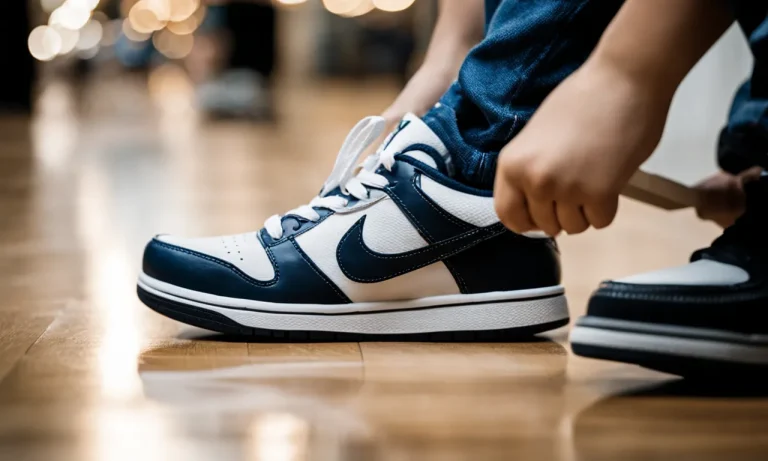Learning to tie shoes is an important milestone for kids, but it can be tricky to teach. If you’re a parent looking for the easiest way to teach your child this essential skill, you’ve come to the right place.
If you’re short on time, here’s a quick answer to your question: Use the bunny ears method, go step-by-step, let them practice, and offer praise and encouragement along the way.
In this comprehensive guide, we’ll cover everything you need to know to successfully teach your child how to tie their shoes. We’ll start with some tips on when to start teaching shoe tying, then provide step-by-step instructions for the bunny ears tying method.
We’ll also offer troubleshooting advice for common issues like tangled laces and backwards loops. By the end, you’ll have all the tools you need to help your kid master this important life skill.
Know When to Start Teaching Shoe Tying
Teaching a child how to tie their shoes is an important milestone in their development. It not only promotes independence but also helps them develop fine motor skills and coordination. However, knowing when to start teaching shoe tying can be a challenge for parents.
Here are some factors to consider:
Consider your child’s motor skills and independence
Before introducing shoe tying, it’s important to assess your child’s motor skills and independence. Can they perform simple tasks such as buttoning their shirts or zipping their jackets? If they struggle with these activities, it may be an indication that they aren’t quite ready for shoe tying.
It’s important to build a foundation of basic motor skills before moving on to more complex tasks like tying shoelaces.
Aim for ages 4-6
While there is no set age for when a child should learn to tie their shoes, most children are developmentally ready between the ages of 4 and 6. At this age, they have the necessary hand-eye coordination and finger dexterity to manipulate the laces and tie a knot.
It’s important to remember that every child is different, so it’s best to gauge their readiness based on their individual abilities rather than solely relying on age.
Look for signs of readiness
There are several signs that indicate a child may be ready to learn how to tie their shoes. These include showing an interest in learning, being able to follow simple instructions, and demonstrating patience and persistence.
Additionally, if your child is able to tie knots with string or ribbons, they may be ready to tackle the challenge of shoe tying. Keep an eye out for these signs and use them as a guide to determine when to start teaching shoe tying.
Remember, teaching shoe tying is a gradual process that requires patience and practice. Start by teaching the basic steps, such as forming loops and tying a simple knot. Encourage your child to practice regularly and provide plenty of positive reinforcement along the way.
Before you know it, they’ll be tying their shoes with ease!
Use the Bunny Ears Method
Teaching children how to tie their shoes can be a challenging task, but the Bunny Ears method is one of the easiest techniques for beginners. This method simplifies the process and makes it fun for kids to learn.
By incorporating a visual representation of bunny ears, children are more likely to grasp the concept and successfully tie their shoes.
Step-by-step instructions
To teach the Bunny Ears method, follow these simple step-by-step instructions:
- Start by teaching your child to cross one lace over the other to create an “X”.
- Then, show them how to take one lace and make a loop, just like a bunny ear.
- Next, guide them to take the other lace and make another bunny ear.
- Show them how to cross the bunny ears over each other.
- Finally, demonstrate how to pull the bunny ears through the loops to create a tight knot.
Repeat these steps several times, allowing your child to practice each step until they feel comfortable with the process. Remember to be patient and encourage them along the way. Positive reinforcement and praise can go a long way in boosting their confidence and motivation.
Let them practice on both feet
Once your child has mastered the Bunny Ears method on one foot, it is important to let them practice on both feet. This will help them develop muscle memory and improve their coordination. Encourage them to tie their shoes independently, but be available for guidance and support if needed.
By allowing your child to practice on both feet, they will become more confident and proficient in tying their shoes. Additionally, it will reinforce the skills they have learned and make the process more automatic for them.
Remember, learning to tie shoes is a milestone for children, and the Bunny Ears method is a fantastic way to make it easier and enjoyable. With patience, practice, and the use of this technique, your child will be tying their shoes with confidence in no time!
Go Slowly and Offer Guidance
Teaching a child how to tie their shoes can be a challenging task. However, by going slowly and offering guidance, you can make the process much easier for both you and your child. Breaking down the task into small steps, demonstrating each step clearly, guiding their hands at first, and being patient and offering praise are all effective strategies to help your child master this important skill.
Break it down into small steps
Instead of overwhelming your child with the entire process of shoe tying at once, it is helpful to break it down into smaller, more manageable steps. Start by teaching them how to hold the shoelaces and make the first knot.
Once they have mastered that step, move on to teaching them how to make the loops and tie a bow. Breaking it down into smaller steps allows your child to focus on one aspect at a time, making it easier for them to learn and retain the information.
Demonstrate each step clearly
Children often learn best through observation, so it is crucial to demonstrate each step of the shoe tying process clearly. Show them how to hold the shoelaces, make the first knot, and create the loops. Use visual aids or diagrams if necessary to help them understand the sequence of steps.
By providing a clear demonstration, you give your child a visual reference to follow, making it easier for them to replicate the actions.
Guide their hands at first
When teaching your child how to tie their shoes, it can be helpful to guide their hands through the motions initially. This hands-on approach allows them to feel the correct movements and develop muscle memory. Start by placing your hands over theirs as they make the first knot and create the loops.
Gradually, as they gain confidence and proficiency, you can decrease your guidance and allow them to perform the actions independently.
Be patient and offer praise
Learning a new skill takes time and practice, so it is important to be patient with your child as they navigate the process of shoe tying. Encourage them to keep trying, even if they make mistakes along the way. Offer praise and positive reinforcement for their efforts and progress.
Remember, learning to tie shoes is a milestone for your child, and acknowledging their achievements will boost their confidence and motivation to continue learning.
Remember, every child learns at their own pace, so it is important to be patient and understanding throughout the process. By going slowly, offering guidance, and providing encouragement, you can make teaching shoe tying an enjoyable and successful experience for both you and your child.
Troubleshoot Common Issues
Dealing with tangled laces
Tangled laces can be a frustrating issue when teaching shoe tying. One effective way to tackle this problem is by teaching children how to properly hold and handle the laces. Encourage them to hold each lace separately and avoid crossing them over each other.
Demonstrating the technique using colorful and easy-to-handle laces can also make the learning process more engaging and less overwhelming for children.
Fixing backwards loops
Backwards loops can be a common mistake when learning how to tie shoes. To address this issue, it is important to emphasize the correct hand movements. Encourage children to make a loop with the lace and then wrap the other lace around it in the right direction.
A helpful tip is to remind them that the bunny ears should face forward, not backward. Practice and repetition are key to mastering this skill.
Reversing left and right
Confusion between left and right can hinder progress in learning to tie shoes. One effective method to overcome this issue is to use visual aids. You can draw or print out large letters “L” and “R” and attach them to the corresponding shoe.
This way, children can easily identify which shoe is for the left foot and which is for the right foot. Additionally, using different colored laces or stickers on the shoes can further reinforce the correct sides.
Encouraging frustrated kids
Learning to tie shoes can be a challenging task for some children, and frustration may arise. It is important to provide a supportive and encouraging environment. Praise their efforts and progress, even if they make mistakes along the way.
Remind them that it takes time and practice to master any new skill. Incorporating fun and enjoyable activities, such as singing a shoe-tying song or using a shoe tying game, can also help keep their motivation high.
Make It Fun and Reward Progress
Teaching a child to tie their shoes can sometimes be a challenging task. However, by making the process fun and rewarding their progress, you can turn it into an enjoyable and positive experience for both you and your child.
Sing songs and play games
One effective way to make shoe tying fun is by incorporating songs and games into the learning process. You can create a catchy tune to sing while demonstrating the steps, or even find popular children’s songs that are already centered around shoe tying.
Additionally, you can turn shoe tying into a game by challenging your child to see how quickly they can complete the task or by creating a race against the clock. These interactive elements can make the learning experience more engaging and memorable for your child.
Use positive reinforcement
Positive reinforcement is a powerful tool when it comes to teaching any new skill, including shoe tying. Praising your child’s efforts and progress can boost their confidence and motivation to continue practicing. You can use verbal praise, such as saying “Great job!” or “You’re doing amazing!”
Additionally, you can incorporate small rewards to further incentivize your child. For example, you can create a reward chart where your child earns stickers or small treats for each successful attempt or milestone reached.
This positive reinforcement not only makes the learning process more enjoyable, but it also reinforces your child’s sense of accomplishment.
Celebrate successes
Celebrating your child’s successes, no matter how small, is an essential part of teaching shoe tying. Each time your child makes progress, take a moment to acknowledge and celebrate their achievement. This can be as simple as giving them a high-five or a hug, or even having a mini celebration with their favorite snack.
By celebrating their successes, you are reinforcing their hard work and dedication, which motivates them to keep practicing and improving.
Remember, teaching shoe tying is not just about the end result of having well-tied shoes. It is also an opportunity to bond with your child, build their confidence, and teach them valuable life skills.
By making the process fun and rewarding their progress, you can make shoe tying an enjoyable experience for both of you.
Conclusion
Teaching your child to tie their shoes is an important rite of passage. While it may take some time and patience, going step-by-step and making it engaging will set them up for success. With the right guidance and encouragement, your kid will master this essential skill and gain confidence and independence.
Remember to start simple, break it down, guide their hands, and praise their progress. Before you know it, shoe tying will become second nature and you’ll both be ready to tie up those laces and head out for new adventures.






